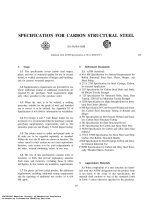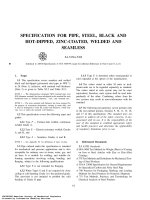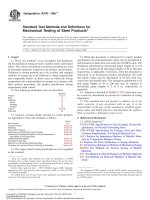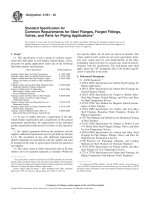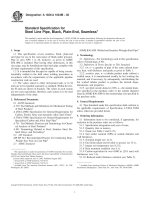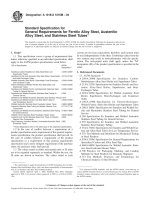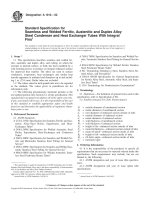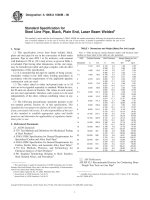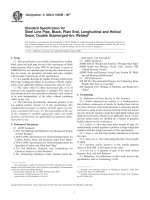Astm a 689 97 (2013)e1
Bạn đang xem bản rút gọn của tài liệu. Xem và tải ngay bản đầy đủ của tài liệu tại đây (80.09 KB, 4 trang )
Designation: A689 − 97 (Reapproved 2013)´1
Standard Specification for
Carbon and Alloy Steel Bars for Springs1
This standard is issued under the fixed designation A689; the number immediately following the designation indicates the year of
original adoption or, in the case of revision, the year of last revision. A number in parentheses indicates the year of last reapproval. A
superscript epsilon (´) indicates an editorial change since the last revision or reapproval.
ε1 NOTE—Editorial changes were made to Sections 1.2, 4.1 and throughout in July 2013.
3.1.5 Bar lengths,
3.1.6 When purchaser’s processing requires cold shearing,
cold punching, and cold trimming, this should be noted.
3.1.7 When special straightness or machine-cut lengths are
required, reference on the purchase order should be made to
Tables A1.10 and A1.9 or Tables A2.10 and A2.9 for SI units
of Specification A29/A29M, and
3.1.8 Weight limitations per shipping bundle.
1. Scope
1.1 This specification covers hot-wrought steel bars to be
used for the manufacture of general-purpose springs such as
coil, torsion, and leaf.
1.2 The values stated in inch-pound units are to be regarded
as standard. The values given in parentheses are mathematical
conversions to SI units that are provided for information only
and are not considered standard.
4. Melting Practice
2. Referenced Documents
4.1 The steel shall be made by one or more of the following
primary processes: basic-oxygen or electric-furnace. The primary melting may incorporate separate degassing or refining
and may be followed by secondary melting using electroslag
remelting or vacuum arc remelting. Where secondary melting
is employed, the heat shall be defined as all of the ingots
remelted from a single primary heat.
2.1 ASTM Standards:2
A29/A29M Specification for Steel Bars, Carbon and Alloy,
Hot-Wrought, General Requirements for
A255 Test Methods for Determining Hardenability of Steel
A304 Specification for Carbon and Alloy Steel Bars Subject
to End-Quench Hardenability Requirements
A322 Specification for Steel Bars, Alloy, Standard Grades
A576 Specification for Steel Bars, Carbon, Hot-Wrought,
Special Quality
E112 Test Methods for Determining Average Grain Size
5. Chemical Composition or Hardenability Requirements
5.1 When the steel is specified by chemical composition, the
standard steel grades are the ASTM series 1000, 4100, 5100,
6100, 8600, and 9200, and those including Boron ASTM series
10B00, 15B00, 50B00, and 51B00. The specific grades are
listed in Specifications A322 and A576.
3. Ordering Information
3.1 Purchase orders for material to this specification shall
include the following information as required to describe the
desired material adequately:
3.1.1 ASTM designation A689,
3.1.2 ASTM grade number indicating the chemical composition (see 5.1), special chemistry required (see 5.2), or
hardenability (see 5.3),
3.1.3 Quantity (number of bars or weight),
3.1.4 Cross section description and dimensions or drawings
of section,
5.2 Modifications may be made in the chemistry of the
standard ASTM grades to suit the hardenability required for a
particular bar size, spring shape, or other special requirements.
The steel supplier should be consulted on availability of any
special chemical compositions.
5.2.1 A chemical analysis of each heat of steel purchased
under 5.1 and 5.2 shall be made by the steel producer to
determine the percentage of the elements, which percentages
shall conform to the requirements of the designated ASTM
grade or special chemistry. The chemical analysis thus determined shall be reported to the purchaser.
1
This specification is under the jurisdiction of ASTM Committee A01 on Steel,
Stainless Steel and Related Alloys and is the direct responsibility of Subcommittee
A01.15 on Bars.
Current edition approved April 1, 2013. Published July 2013. Originally
approved in 1974. Last previous edition approved in 2007 as A689 – 97 (2007)ϵ1.
DOI: 10.1520/A0689-97R13E01.
2
For referenced ASTM standards, visit the ASTM website, www.astm.org, or
contact ASTM Customer Service at For Annual Book of ASTM
Standards volume information, refer to the standard’s Document Summary page on
the ASTM website.
5.3 When the steel is specified by end-quench hardenability
requirements (alloy steels), the grade is identified by the suffix
letter “H.” The standard alloy steel grades are the ASTM series
4100H, 5100H, 6100H, 8600H, and 9200H and those including
Boron ASTM series 50B00H and 51B00H. The specific grades
are listed in Specification A304.
Copyright © ASTM International, 100 Barr Harbor Drive, PO Box C700, West Conshohocken, PA 19428-2959. United States
1
A689 − 97 (2013)´1
TABLE 1 Rounded Corner Radii
Specified Sizes,A in. (mm)
0.250 (6.35) to 0.375 (9.52)
0.375 (9.52) to 0.500 (12.70)
Over 0.500 (12.70) to 0.813 (20.65)
Over 0.813 (20.65) to 1.469 (37.31)
Over 1.469 (37.31) to 1.938 (49.23)
Over 1.938 (49.23) to 2.438 (61.93)
Nominal Corner Radii,
in. (mm)
0.031
0.063
0.094
0.125
0.250
0.313
(0.78)
(1.60)
(2.38)
(3.18)
(6.35)
(7.94)
A
Sizes are distances between opposite sides of square bars and the thickness of
rectangular bars.
6.4 Round Bars—For section tolerances see Table A1.1 or
A2.1 for SI units of Specification A29/A29M.
5.3.1 Hardenability requirements (band limits) shall be
shown on the purchase order as outlined in the applicable
sections of Specification A304.
5.3.2 The end-quench hardenability tests from each heat of
steel shall be made in accordance with Test Methods A255,
with the exception that a cast hardenability test specimen may
be acceptable. The test results shall conform within the
specified limits and shall be reported to the purchaser.
6.5 Special Cross Section Shapes, such as Keystone—A
drawing of the cross section including the tolerances should
accompany the purchase order. It is recommended that the steel
supplier be contacted concerning the availability of any special
cross section.
6.6 Length and Straightness of Bars:
6.6.1 For straightness and length tolerances, see Tables
A1.10 and A1.8, or Tables A2.10 and A2.8 for SI units of
Specification A29/A29M.
6.6.2 When special straightness or machine-cut length are
required, this must be clearly noted on the purchase order and
reference made to Tables A1.10 and A1.9 or Tables A2.10 and
A2.9 for SI units of Specification A29/A29M.
6. General Requirements
6.1 The hot-wrought bars shall be furnished in the aswrought condition and shall conform to the general requirements as outlined in Specification A29/A29M, excepting that
the spring steel bars shall not be marked by hot- or coldstamping unless specified by the purchaser.
6.2 Flat bars for leaf springs unless otherwise specified shall
be round-edge flat steel having two flat surfaces and two round
(convex) edges. The cross section tolerances permit the two flat
surfaces to be slightly concave. When there is concavity, the
radii of the arcs of the two concave surfaces shall be approximately the same length.
6.2.1 The round edges shall approximate circular arcs with
a radius of curvature between 65 to 85 % of the thickness of the
bar.
6.2.2 Round-edge flat bars shall conform to the cross
section tolerances specified in Table 2.
6.7 The austenitic grain size shall be No. 5 or finer as
determined by Test Methods E112.
7. Workmanship, Finish, and Appearance
7.1 The bars shall be free of injurious defects and shall have
a workmanlike finish consistent with good hot-rolling practices
for bars intended for use in springs.
8. Rejection and Rehearing
8.1 Steel that fails to conform to the requirements of this
specification or shows injurious defects after its receipt by the
purchaser, or both, shall be rejected and the supplier shall be
notified for disposition.
6.3 Flat (Rectangular and Including Square) Bars with
Rounded Corners:
6.3.1 The rounded corner radii shall be in accordance with
Table 1.
6.3.2 For section tolerances see Table A1.3 or A2.3 for SI
units (for rectangular bars) and Table A1.1 or A2.1 for SI units
(for square bars) of Specification A29/A29M.
9. Product Marking
9.1 The bars shall be properly bundled for shipment and
identified as to size, weight, heat number, grade designation,
purchase order number, and name of supplier.
2
3
2.50
4.00
5.00
6.00
(63.5)
(101.6)
(127.0)
(152.4)
To and
including
+0.030
+0.045
+0.065
+0.090
(0.76)
(1.14)
(1.65)
(2.28)
Minus 0.000
±0.005 (0.13)
±0.006 (0.15)
±0.007 (0.18)
...
±0.006
±0.008
±0.010
±0.012
(0.15)
(0.20)
(0.25)
(0.30)
...
±0.012 (0.30)
±0.016 (0.40)
±0.020 (0.51)
0.005 (0.13)
0.006 (0.15)
00.007 (0.18)
...
0.375 (9.52) or
Under
0.006
0.008
0.010
0.012
(0.15)
(0.20)
(0.25)
(0.30)
...
0.012 (0.30)
0.016 (0.40)
0.020 (0.51)
Over 0.875
(22.22) to 1.500
(38.10), incl
Over 0.375
(9.52) to 0.875
(22.22), incl
Over 0.875
(22.22) to 1.500
(38.10), incl
Over 0.375
(9.52) to 0.875
(22.22), incl
0.375 (9.52) or
Under
Tolerance in ConcavityB of Flat Surfaces, in. (mm)
ToleranceA in Thickness, in. (mm)
TABLE 2 Cross Section Tolerances for Round-Edge Flat Bars
0.002 (0.05)
0.003 (0.07)
0.004 (0.10)
...
0.375 (9.52) or
Under
0.002
0.004
0.005
0.006
B
(0.05)
(0.10)
(0.13)
(0.15)
Over 0.375
(9.52) to 0.875
(22.22), incl
...
0.006 (0.15)
0.008 (0.20)
0.010 (0.25)
Over 0.875
(22.22) to 1.500
(38.10), incl
Max Difference in Thickness,C in. (mm)
Thickness measurements are taken at the edges of the bar where the flat surfaces intersect the rounded edges.
Concavity is the difference between the thickness at the center of the bar and the thickness at the edges. The thickness at the center should not exceed the thickness at the edges.
C
Maximum difference in thickness between the two edges of each bar.
A
0.00
2.50 (63.5)
4.00 (101.6)
5.00 (127.0)
Over
Specified Width, in. (mm)
Tolerance in
Width, in. (mm)
A689 − 97 (2013)´1
A689 − 97 (2013)´1
ASTM International takes no position respecting the validity of any patent rights asserted in connection with any item mentioned
in this standard. Users of this standard are expressly advised that determination of the validity of any such patent rights, and the risk
of infringement of such rights, are entirely their own responsibility.
This standard is subject to revision at any time by the responsible technical committee and must be reviewed every five years and
if not revised, either reapproved or withdrawn. Your comments are invited either for revision of this standard or for additional standards
and should be addressed to ASTM International Headquarters. Your comments will receive careful consideration at a meeting of the
responsible technical committee, which you may attend. If you feel that your comments have not received a fair hearing you should
make your views known to the ASTM Committee on Standards, at the address shown below.
This standard is copyrighted by ASTM International, 100 Barr Harbor Drive, PO Box C700, West Conshohocken, PA 19428-2959,
United States. Individual reprints (single or multiple copies) of this standard may be obtained by contacting ASTM at the above
address or at 610-832-9585 (phone), 610-832-9555 (fax), or (e-mail); or through the ASTM website
(www.astm.org). Permission rights to photocopy the standard may also be secured from the ASTM website (www.astm.org/
COPYRIGHT/).
4
